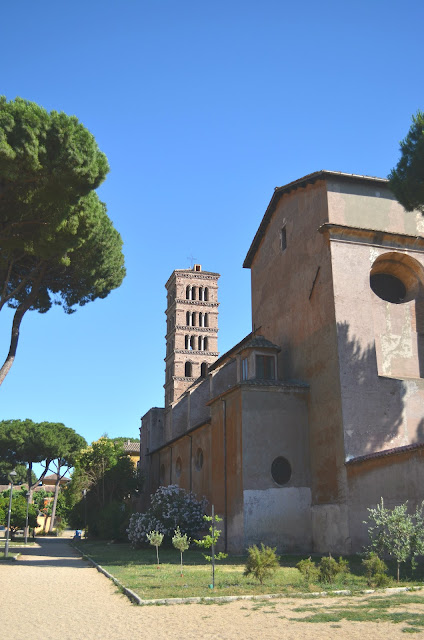As you know, we visited Rome last month. It was a really hot summer weekend. After visiting Eataly, we headed to visit the Aventine hill, an area in which we had never been before. So we took a bus from our hotel that dropped us at the foot of the hill, next to the Tevere river.
We climbed through Via di Rocca Savella until we got to the top, more precisely, to the square called Piazza dei Cavalieri di Malta where the famous "Roman keyhole" is. The Roman keyhole is located in the door of the building which belongs to the Order of Malta. If you look through the keyhole, you'll see the dome of St. Peter's basilica, pretty cool right?
 |
| Order of Malta |
Guess someone parked in the wrong place... very Italian... Fortunately, I managed to get a quick shot from the cloister before we were escorted out, I guess that's what we were supposed to see from the keyhole.
This is a pro's photo of what you should see through the Roman keyhole (taken from this website):
After this letdown, we proceeded to the neighboring Garden of Oranges (Giardino degli Aranci), or Parco Savello, a beautiful, relaxing garden overlooking the city.
It is located next to the ancient Basilica of Santa Sabina.
You will be greeted by the scary face of Giacomo Della Porta's fountain, probably inspired by the god Oceanus.
On a side of the garden are the remains of a wall of the Savelli Castle. The Dominican Order transformed the castle into a monastery, and the small park into a vegetable garden.
On a side of the garden are the remains of a wall of the Savelli Castle. The Dominican Order transformed the castle into a monastery, and the small park into a vegetable garden.
Legends says that Spanish Saint Dominic gave the garden its name, and its first orange tree: having transported the sapling from his homeland, he planted it close to the cloister where it flourished. Legend also says how Saint Catherine of Siena picked the oranges from this tree and made candied fruit, which she gave to Pope Urban VI.
The tree remains to this day, visible through a "porthole" in the wall of the nave. Miraculously, a younger sapling grew on its remains, which continues to bear fruit.
Years later, orange trees were added to the monastery garden, which became known as the Garden of Oranges. Though they produce bitter fruit (that's why nobody was picking them up!), they give a pleasant shady air to the garden, affording a lovely retreat from the bustle and noise of urban life.*
Years later, orange trees were added to the monastery garden, which became known as the Garden of Oranges. Though they produce bitter fruit (that's why nobody was picking them up!), they give a pleasant shady air to the garden, affording a lovely retreat from the bustle and noise of urban life.*
After relaxing in the garden we came down the hill to the Circo Massimo (Circus Maximus), the ancient venue for races and public games, now used for concerts and meetings.
We walked to the Tevere, the ancient temples of the Forum Boarium and Santa Maria in Cosmedin (where the Mouth of Truth is found).
TBC...



















No comments:
Post a Comment